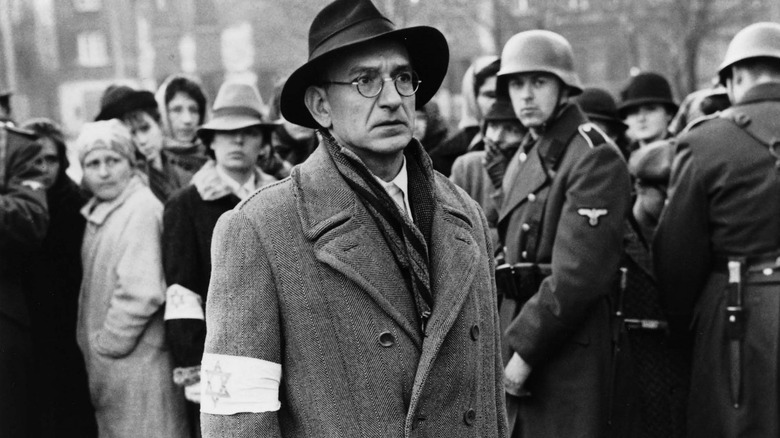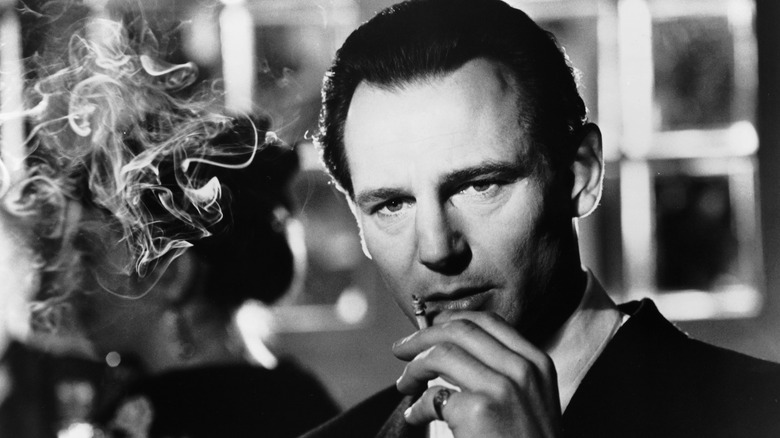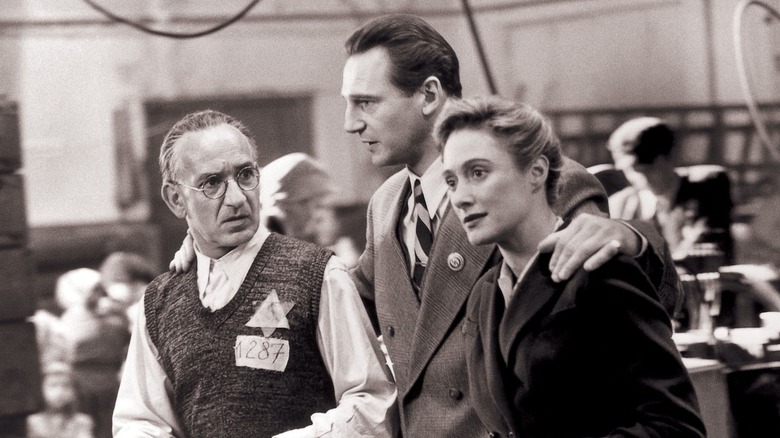How The Cast Of Schindler's List Dealt With The Constant Darkness Of The Film
The title character of Steven Spielberg's 1993 film "Schindler's List" performed numerous heroic acts during World War II, but is not depicted as being the least bit conventionally "heroic." He's a flawed alcoholic who, at the outset of World War II, sees a business opportunity in hiring Jewish workers. In so doing, however, his employees were protected from being apprehended by the Nazis. All told, Oskar Schindler rescued some 1,200 people from the Reich.
Spielberg looks the horrors of the war right in the eye. The film features multiple harrowingly accurate scenes of death, torture, and vicious wartime brutality. Hate and fear undergird far too much of the world. In a potent symbol — based on real life — a walkway into a concentration camp is paved by pilfered tombstones. In the film's most famous sequence, a young girl in a red coat is seen wandering among chaotic wartime streets, death hanging over the crowds of soldiers and citizens. Her dress is red while the film around her is in black and white.
Of course, filming a WWII film is going to be intense. Actors will not only have to learn some of the horrifying details of the war, but they will have to reenact them. The pain, the death, the fear, all needed to be lived out in front of the cameras. The very subject matter of "Schindler's List" likely caused emotional struggles that boggle the imagination.
In a 1994 article by journalist John H. Richardson, printed in the 2014 book "Steven Spielberg: Interviews" edited by Lester D. Friedman Brent Notbohm, the cast's "unwinding" process is described in detail. It turns out that, in order to decompress, one just needs to remind oneself of humanity in a warm bar full of camaraderie.
The hotel lobby in Krakow
Spielberg began filming "Schindler's List" on March 1, 1993 in Krakow, Poland. It's notable that Spielberg wrapped production on "Jurassic Park" in late November of 1992, giving him only five months to get his next film started. Both films were released in '93. Some enterprising archivists have sought out and located the shooting locations used for "Schindler's List," almost all of them in or around Krakow. In Franciszek Palowski's 1998 book "The Making of Schindler's List: Behind the Scenes of an Epic Film," it is explained that the concentration camps were constructed from scratch, as the actual camps were now too close to modern cities.
The entire city, it would seem, was temporarily devoted to the war. The film's shooting schedule luckily accommodated for gatherings in the Krakow hotel lobby for drinks and gentle carousal. Not a party, mind you, but gentle conversation. A way to reconnect with humanity. The cast would talk to each other, as they would to actual Holocaust survivors, appreciating life.
Richardson describes an encounter that actor Ben Kingsley, who play Itzhak Stern in "List," had with one of said survivors. She leaned over to give him a kiss, knocking over his wine glass. Kingsley, evidently, was unperturbed. "A kiss is still a kiss, even though it spills wine all over you," he said. Liam Neeson, who played Schindler, joined the crowd with his visiting wife Natasha Richardson.
John H. Richardson evokes a warm, gorgeous, happy atmosphere, heavy with cigarette smoke and alcohol. "We go out in the evenings and listen to loud music and eat and drink and hug each other," Kingsley was quoted as saying, "because at the end of a day in hell you treasure life and you treasure your loved ones."
That's lovely.
The mood on the set
One might search through any film journal or online magazine and find many examples, positive and negative of "the mood on the set." Anecdotally, readers might have heard how certain lightweight comedy films have stern, scientific shoots wherein there is little giggling happening on the side. Some documentary footage of a horror movie shoot will reveal, among the blood and gore, a group of people laughing and gamboling and having a wonderful time. Clint Eastwood in on record with his preference for "relaxed" sets without a lot of noise and chatter. William Friedkin infamously likes the opposite, playing loud music and shooting pistols off camera to keep everyone on edge.
Often, the most intense movies of all have to assure the mood is light to prevent stress and breakdown. Gaspar Noé, while often filming scenes of extreme insanity, can keep the mood very upbeat. Evidently, there were a lot of fart jokes told on the set of "Interview with the Vampire."
Something extra was seemingly needed for "Schindler's List." There's no way to keep the mood light when dealing with real-life Nazi war atrocities. Once can be sure there were no titters or flatulence gags. There was just the raw, harrowing facts of the world's most destructive era underpinned by prejudice, hate, and the dark wherewithal an entire political party possessed to carry out their insane campaigns. After that, one doesn't need a joke. One needs humanity. One needs genuine warmth.
The streets of Krakow provided. And, one might hope, the joy and the humanity from the actors fed back into the city.


